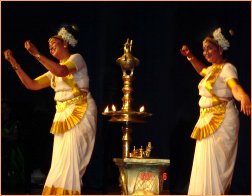 |
 |
Atlanta hosts the ‘Ambassador of Mohiniattom’ by Arun P Madangarli e-mail: maalu@juno.com
|
 |
| The
lights dim, and there is an expectant hush as the audience falls silent.
A spark of light appears on the darkened stage, which sways and flickers
and then grows into a flame from a burning wick. A dancer, a vision
attired in the purest of whites, steps slowly, languorously to the front
of the stage, bearing in her hand the traditional ‘Nilavilakku’ (lamp)
of Kerala.
No, this scene was not set in ‘God’s own country’ in the south-east corner of India. It was at the Hindu Temple of Atlanta in Riverdale, Georgia, and the occasion was the mesmerizing evening of Mohiniattom performance by Kalamandalam Radhika on September 6, 2003. Atlanta (like
most cosmopolitan U S cities) has an over-abundance of regional cultural
associations from India, all offering diverse windows through which the
rich panoply of Indian culture might be viewed. Still, no forum had
yet hosted any classical event that was truly from Kerala, the birthplace
of two of India’s seven classical dance forms.
Mohiniattom
is one of the most graceful and sensuous classical dance forms to have
evolved in south India. With its highly emotive hand gestures and
eye movements that are unique to this art form, the artiste etches in real
life the celestial Mohini, who charmed away the elixir of life from the
asuras who stole it. And Radhika is a doyen of this art, a veritable
Mohini, who with her daring and original experiments and explorations at
the frontiers of this dance form has given it entirely new dimensions.
This exemplary artiste who started her ‘kalopasana’ (worship of art) at
the tender age of three has choreographed and performed Mohiniattom items
in several languages. She has drawn her themes from extremely diverse
sources such as Biblical stories and poetical works like those of Kuvempu,
Amruth Someshwar, Veerappa Moily, Fr. Abel and St. Chavara. She has
performed in such a multitude of national and international forums, The
Hindu calls her ‘The Ambassador of Mohiniattom’.
Radhika rendered seven items during her performance, starting with a Navarasanjali composed by K C Kesavapillai, in which the goddess Kali is propitiated by an offering of the ‘Navarasas’ (the nine emotions) that form the cornerstone of Indian aesthetics. This was followed by ‘Omanathinkal Kidavo,’ the quintessential lullaby composed by Irayimman Thampi that plucks at the heartstrings of everyone who follows its gentle, soothing melody. The audience sat entranced, wafted away to those halcyon days of childhood on the wings of nostalgia, while this piece was being performed. Another item from Radhika’s repertoire was ‘’Radhika, Tava Virahey Kesava’ the ninth ashtapadi from Gita Govindam, in which the artiste rendered a superb exposition of the purva raga aspect of vipralambha sringara rasa. A most delightful varnam (‘Karmukil Oli Varna, Kanna…’) dedicated to Lord Guruvayoorappan (Krishna) followed, which related tales of the Lord’s compassion. In fact, this item demonstrated the scope and extent to which abhinayam plays a role in Mohiniattom, as Radhika gave an extremely moving portrayal of a little boy’s grief, and his innocent, selfless love for Guruvayoorappan, that left the audience teary eyed. Maharaja Swati Tirunal’s famous padam ‘Panimathi Mukhi Bale...’ brought out all the elements that immortalizes Mohiniattom, where, while staying rooted in the sthayi bhava of sringara, the virahothkhandita nayika runs a gamut of emotions as she recounts the bliss she had in the arms of her lover, her sorrow at his absence and her anger at his treachery when the time to rendezvous passes and he does not visit her. This highly erotic padam offered a backdrop against which Mohiniattom could be compared with dance forms such as Bharatanatyam that developed in temple-precincts. Mohiniattom, with its coquetry that is aimed at seduction is highly secular, whereas in the other dance forms every movement and emotion has to be subjugated to bhakti. The famous kriti ‘Krishna nee begane baro…’ was perhaps the most compelling instance of Radhika’s experimentations with the form and content of Mohiniattom, in which she illustrated how this art form can transcend the limitations imposed by artificial barriers like language. This Kannada piece that is not part of the traditional Mohiniattom repertoire had never been performed as a Mohiniattom item until Radhika choreographed it. In this, the artiste explores every aspect of a mother’s love for her child. The item ends when Krishna’s mother sees the entire universe in his mouth, at which point the motherly love transcends into bhakti. The last item on this memorable evening was a thillana that brought out all the intricate and graceful movements of Mohiniattom. A most noble and laudable aspect of this Mohiniattom performance was that all the proceeds from this go to a charitable trust called ‘Nritya Dhara’ that seeks to ameliorate the living conditions of elderly and indigent artists who have long been forgotten by their fans and family. In Kalamandalam Radhika’s words, “None of what I show on the stage is mine; everything comes from the blessing and munificence of God. I am thankful that He has chosen me to be a distributor of joy in the form of Mohiniattom. And if by doing what I do, I can wipe the tears of these old and helpless masters, I need no other reward”. A noble sentiment
indeed!
Arun P Madangarli is an electrical engineer, art enthusiast and a literary writer. He can be contacted at maalu@juno.com Gita Maheshwaran, a supporter and promoter of Kerala classical art forms can be contacted at mangika@yahoo.com
|